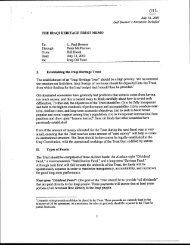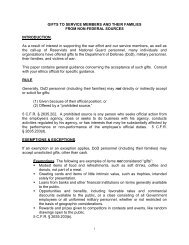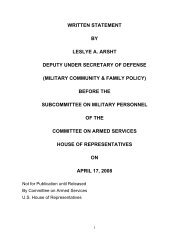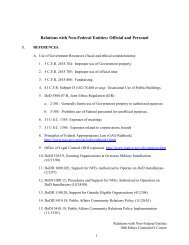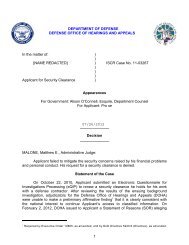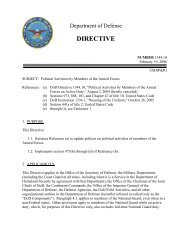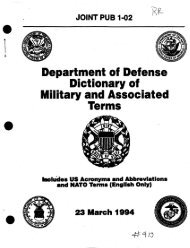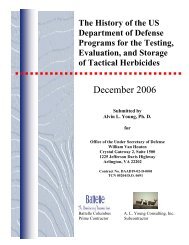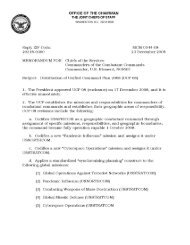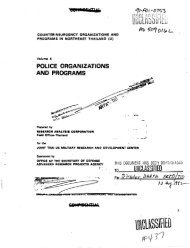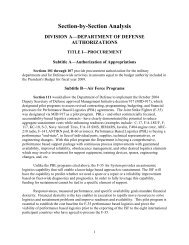statement of mr. thomas p. dee director, joint rapid acquisition cell ...
statement of mr. thomas p. dee director, joint rapid acquisition cell ...
statement of mr. thomas p. dee director, joint rapid acquisition cell ...
- No tags were found...
Create successful ePaper yourself
Turn your PDF publications into a flip-book with our unique Google optimized e-Paper software.
STATEMENT OFMR. THOMAS P. DEEDIRECTOR, JOINT RAPID ACQUISITION CELLOFFICE OF THE UNDER SECRETARY OF DEFENSE(ACQUISITION, TECHNOLOGY AND LOGISTICS)BEFORE THEHOUSE ARMED SERVICES COMMITTEETactical Air and Land SubcommitteeMarch 1, 2011
Chairman Bartlett, Ranking Member Reyes, and Members <strong>of</strong> the Tactical Air and Land Subcommittee:Thank you for the opportunity to appear before you today to discuss the Department <strong>of</strong> Defense’s (DoD)Joint Urgent Operational Needs (JUONs) process.The experience <strong>of</strong> war has taught us that new enemy weapons and tactics will emerge in times <strong>of</strong>conflict and that we will not always have existing capability or capacity to adequately counter those newthreats. From the “torpedoes” <strong>of</strong> Mobile Bay and mustard gas in Flanders to the German wolf packs <strong>of</strong>the North Atlantic and the Air Defense system <strong>of</strong> North Vietnam, our nation has routinely facedunexpected threats that have required urgent responses. The underlying purpose <strong>of</strong> the Department’sJUONs process is to <strong>rapid</strong>ly provide our warfighters with the capabilities they need to address new andevolving threats and opportunities.While it is impossible to anticipate every emerging threat on the battlefield, the accelerating pace <strong>of</strong>technology development and commercial innovation provides DoD with an opportunity to <strong>rapid</strong>lydevelop and field new capabilities to counter each threat and ensure that the decision cycle advantageremains with our forces, regardless <strong>of</strong> whether we were prescient enough to anticipate each emergingthreat or each technology opportunity during previous budget cycles.As is the case for our deliberate requirements and resource allocation processes – the Joint CapabilitiesIntegration and Development System (JCIDS), Planning, Programming, Budgeting and ExecutionSystem (PPBES), and <strong>acquisition</strong> processes – the JUONS process is comprised <strong>of</strong> three main elements:(1) deciding what you need (requirements); (2) providing adequate resources to buy it (programmingand budgeting); and (3) assessing alternatives and executing a solution (<strong>acquisition</strong>), to includeoperation and maintenance.The challenge for the JUONs process is how to execute each element on a much more compressedtimeline, <strong>of</strong>ten in the absence <strong>of</strong> well-defined requirements, supporting CONOPS and doctrine, and/orsupporting operations and maintenance concepts. As we compress our timelines to satisfy urgent needs,the Department necessarily accepts some higher level <strong>of</strong> programmatic (cost, schedule, performance)risk in order to reduce the Commander’s operational risk. At a time <strong>of</strong> war, “schedule” <strong>of</strong>ten becomesthe risk that is least acceptable because the speed at which something can be fielded, even if it is only amitigating capability, is <strong>of</strong>ten the most relevant factor in reducing the Commander’s operational risk.Not surprisingly, therefore, the Commander’s assessment <strong>of</strong> his operational risk is where the urgentneeds process begins.As identified in a recent GAO study 1 , there are multiple mechanisms through which a Commander cansubmit an urgent operational need request. Appropriately, under their Title 10 responsibilities, theService components have all established processes to facilitate a timely response to identified warfighter1 GAO-10-460 April 2010, Warfighter Support: Improvements to DOD’s Urgent Needs Processes Would Enhance Oversightand Expedite Efforts to Meet Critical Warfighter Needs, pg 9.1
needs 2 . Additionally, US Special Operations Command (USSOCOM) and the Joint IED DefeatOrganization (JIEDDO) have written policies and processes for managing urgent needs 3 . While theArmy alone has handled over 10,000 such operational needs <strong>statement</strong>s, all Services have responded tourgent operational needs through their service-specific <strong>rapid</strong> <strong>acquisition</strong> processes.In cases where a Commander identifies the need as <strong>joint</strong>, the Combatant Commander certifies therequirement and forwards it to the Chairman <strong>of</strong> the Joint Chiefs <strong>of</strong> Staff for validation as a Joint UrgentOperational Need (JUON) 4 . There have been more than 300 such needs forwarded by US CentralCommand (CENTCOM) to the Joint Staff for validation since 2006. The Joint Staff Director for ForceStructure, Resources and Assessments (J8) uses its established Functional Capability Boards (FCBs) toassess both the validity and urgency <strong>of</strong> the requirement. As part <strong>of</strong> their review, the FCBs considerwhether the requirement has already been identified through some other means (Integrated Priority List,JCIDS, etc.), whether funding has been programmed or requested, whether a non-material solutionmight be sufficient, and whether there may be overlap with other efforts within the Department. Shouldthe Joint Staff J8 Deputy Director for Requirements (DDR) determine that the need is valid and that it isurgent 5 , he passes it to me as the Director <strong>of</strong> the OSD Joint Rapid Acquisition Cell (JRAC).The JRAC was established by the Deputy Secretary <strong>of</strong> Defense in 2004 to facilitate the resolution <strong>of</strong>immediate warfighter needs. As such, we coordinate with the Service Components, JIEDDO, theIntelligence Surveillance and Reconnaissance (ISR) Task Force, other elements <strong>of</strong> OSD including the<strong>of</strong>fices <strong>of</strong> the Assistant Secretary <strong>of</strong> Defense Research and Engineering (ASD R&E) and Logistics andMaterial Readiness (ASD L&MR), and various defense agencies to identify potential solutions to thevalidated requirement and any challenges, or risks, associated with executing that solution. We thenformally task the appropriate component with the responsibility to satisfy the need.As I indicated earlier, there are many challenges associated with compressing the requirements,budgeting and <strong>acquisition</strong> cycle. While some solutions may be relatively straightforward, such asprocuring additional commercially available optics suites, or commercial satellite communicationssystems, in other cases, they can be more complex, such as a current effort to engineer multiple maturetechnologies to develop a new weapons system that minimizes collateral effects, or to find a <strong>rapid</strong>solution to the physics challenge <strong>of</strong> detecting homemade explosives from a safe stand-<strong>of</strong>f range.2 U.S. Army, Material Development, Army Regulation 71-9, December 28, 2009; U.S. Navy, Dept <strong>of</strong> the Navy Urgent NeedsProcess, SECNAVNOTE 5000, March 12, 2009; USMC, Marine Corps Expeditionary Force Development System, MCO3900.17, October 17, 2008; USAF, Rapid Response Process, USAF instruction 63-114, June 12 2008.3 USSOCOM, Special operations Forces Capabilities and Development System, USSOCOM Directive 71-4 (draft) June2009. DOD Directive 2000.19 (Joint IED Defeat Organization) February 14, 2006 (under revision).4 Joint Urgent Operational Need (JUON) – An urgent operational need identified by a combatant commander involved in anongoing named operation. A JUON’s main purpose is to identify and subsequently gain Joint Staff validation and resourcingsolution, usually within days or weeks, to meet a specific high priority combatant commander need. The scope <strong>of</strong> acombatant commander JUON will be limited to addressing urgent operational needs that: (1) fall outside <strong>of</strong> the establishedService processes; and (2) most importantly, if not addressed immediately, will seriously endanger personnel or pose a majorthreat to ongoing operations.5 The guiding policy for the development, submission and validation <strong>of</strong> a JUON is contained in CJCS Instruction 3470.1.(currently under revision)2
Almost all solutions have complex integration challenges to enable interoperability with existingsystems and most require non-standard training, or even doctrinal changes.Despite these challenges, through our urgent needs processes, the Department has provided our forceswith the best force protection, command and control, counter-IED and ISR capabilities available.That is not to say that the Department is satisfied with our processes, with the speed at which we canfield new capabilities, at our ability to anticipate the next threat, or with the efficiency with which thewhole process works. In the 2010 Quadrennial Defense Review (QDR), the Department recognized acontinuing need to build agile, adaptive, and innovative structures capable <strong>of</strong> quickly identifyingemerging gaps and <strong>rapid</strong>ly adjusting program and budgetary priorities to mitigate those gaps 6 . Oururgent processes must provide a means <strong>of</strong> quickly prioritizing and quantifying requirements and <strong>of</strong>ensuring that the resources are available to enable <strong>rapid</strong> fielding <strong>of</strong> capabilities inside <strong>of</strong> theDepartment’s PPBES cycle.The Department has also acknowledged, and largely concurred with, the findings and recommendations<strong>of</strong> the April 2010 GAO report on DoD’s Urgent Needs processes. Contained in that reports arerecommendations that DoD implement a comprehensive management framework with better definedaccountability to improve our responsiveness to urgent operational needs. Section 804 <strong>of</strong> the FY 11National Defense Authorization Act further directs the Department to conduct a complete review <strong>of</strong> theprocess for fielding capabilities in response to urgent operational needs to include consideration <strong>of</strong>earlier GAO reports and a July 2009 congressionally-directed study by the Defense Science Board TaskForce on Fulfillment <strong>of</strong> Urgent Operational Needs. That review is to consider a streamlined and tightlyintegrated approach to the Department’s urgent needs processes, clear definition <strong>of</strong> the roles andresponsibilities within the department for the fulfillment <strong>of</strong> urgent needs, and the development <strong>of</strong> anexpedited review process to determine which needs are appropriate for a <strong>rapid</strong> fielding process.Concurrent with the development <strong>of</strong> these many reports, the Department has also been adapting itsurgent processes in response to our experiences in Iraq and Afghanistan. Beginning in 2009, thePresident’s revised strategy in Afghanistan has served as a catalyst to initiate, if not fully implement,many <strong>of</strong> the actions recommended in the GAO reports. Among the common findings <strong>of</strong> many <strong>of</strong> thesereports is the perceived lack <strong>of</strong> a common management framework and clear senior leadership <strong>of</strong> oururgent needs processes. Recognizing the need for improved synergies among the multiple organizationsthat contribute to the counter-IED campaign, the Secretary <strong>of</strong> Defense established the Counter-IEDSenior Integration Group (C-SIG) in November 2009 to leverage the efforts <strong>of</strong> JIEDDO, the militaryservices, the defense agencies, the MRAP Task Force and the ISR Task Force. Under the leadership <strong>of</strong>Under Secretary <strong>of</strong> Defense (AT&L) Ashton Carter, and the Joint Staff Director <strong>of</strong> Operations (J3) Lt.Gen. Jay Paxton, the C-SIG provided clear priorities and common focus in the Counter-IED fight.It quickly became clear, however, that counter-IED is not a strictly confined problem set. Multiplecapabilities ranging from ISR to force protection contribute to a successful C-IED campaign.6 Quadrennial Defense review report, February 2010, pp 80-81.3
Under USD(AT&L) Carter’s leadership and with the Secretary’s consent, the C-SIG has evolved toinclude oversight <strong>of</strong> many <strong>of</strong> the most critical urgent needs <strong>of</strong> our operational Commanders. While thisevolved role <strong>of</strong> the C-SIG does not yet enjoy the clarity <strong>of</strong> a written policy directive, this seniorgovernance board provides Department-wide focus on expediently meeting the urgent needs <strong>of</strong> ourCommanders.A recent organizational change indicative <strong>of</strong> this improved senior leader focus was the realignment <strong>of</strong>my <strong>of</strong>fice, the Joint Rapid Acquisition Cell, from the Rapid Fielding Directorate <strong>of</strong> the Office <strong>of</strong> theAssistant Secretary <strong>of</strong> Defense for Research and Engineering (ASD R&E), to a direct report to the USD(AT&L). This organizational change has streamlined the decision process for those urgent needssubmitted by the operational Commanders and validated by the Joint Staff. For example, multipleurgent needs that had been identified since the beginning <strong>of</strong> this fiscal year had been languishing forlack <strong>of</strong> funding. With his direct involvement in the process, USD(AT&L) Carter was able to quicklybring the issue to the attention <strong>of</strong> Secretary Gates, who convened a meeting <strong>of</strong> the Department’sleadership and made a decision to immediately fund and execute these urgent needs. Within theauthorities available to the Department, $350M was quickly realigned to support those critical needs thatcould be executed within 60 days. An additional $1B <strong>of</strong> requirements was also quickly sourced, butsince the Department did not have the authority to reapportion these funds, a prior notificationreprogramming request was submitted to Congress for approval. While the HASC has yet to act on thisrequest, both appropriation committees have approved all <strong>of</strong> the requested additions. Unfortunately, dueto the Department acting without an FY11 appropriation, the Department lacks an FY11 source tosupport the requested urgent Operation and Maintenance (O&M) requirements. Nevertheless, thisaction demonstrates the Department’s commitment, at the very highest levels, to quickly make thedecisions necessary to respond to warfighter requirements.Another example <strong>of</strong> improved focus on urgent needs is the increased use <strong>of</strong> the Rapid AcquisitionAuthority provided in section 811 <strong>of</strong> the Ronald W. Reagan National Defense Authorization Act forFiscal Year 2005 (Public Law 108–375) and further amended this year. Use <strong>of</strong> this authority isidentified as an interest item in the HASC Oversight Agenda for the 112 th Congress, and I would like totake this opportunity to thank the committee for its action in the FY 11 NDAA in expanding thisauthority to include supplies as well as equipment and, more importantly, for expanding the authorityfrom $100M to $200M per fiscal year. The Department has already made use <strong>of</strong> this expanded authorityand used $116M as part <strong>of</strong> the aforementioned decision by the Secretary to immediately fund those mosturgent and executable needs.As our management framework continues to evolve, our processes and policies must ensure that allComponents place appropriate priority and use all available authorities to deliver timely and effectivecapabilities to meet the urgent needs <strong>of</strong> our Operational Commanders. To that end, in March 2010,USD(AT&L) Carter issued a memorandum to the Service components highlighting the flexibleauthorities provided through the existing <strong>acquisition</strong> regulations and policy and directing them, shouldthose existing authorities be insufficient to enable a <strong>rapid</strong> response, to request use <strong>of</strong> Rapid AcquisitionAuthority.4
Although now separate from the JRAC, ASD (R&E)’s Rapid Fielding Directorate continues to focus onanticipating emerging needs and the <strong>rapid</strong> demonstration <strong>of</strong> potential technology solutions. Chargedwith discovering the best and most relevant technologies from the commercial and public sector, this<strong>of</strong>fice is working to better leverage the science and technology community throughout the Department t<strong>of</strong>ocus on supporting the current fight through <strong>rapid</strong> technology demonstrations and <strong>rapid</strong> prototypingefforts. Among the Rapid Fielding Directorate’s many recent contributions are demonstrations <strong>of</strong> analternative persistent ground surveillance system, a Vehicle and Dismount Exploitation Radar(VADER), a foliage penetrating Light Detection and Ranging (LIDAR) radar system, and an enhancedmortar targeting system. All <strong>of</strong> these projects are currently fielded in Afghanistan.While the Department has enjoyed many successes in <strong>rapid</strong>ly delivering capabilities to the field, thereare still challenges to overcome. As I indicated earlier, the most difficult challenge in “<strong>rapid</strong><strong>acquisition</strong>” is not <strong>acquisition</strong>, but rather prioritizing needs and quickly identifying the resources neededto execute a solution. Congress cannot help us with prioritizing our warfighting needs, but it can help t<strong>of</strong>acilitate their <strong>rapid</strong> funding. The increase <strong>of</strong> Rapid Acquisition Authority has helped, but identifyingnew funding in the year <strong>of</strong> execution remains a challenge. Since the exhaustion <strong>of</strong> the Iraqi FreedomFund (IFF) 7 , the Department has had no appropriation, except for counter-IED and MRAP, dedicated tosupport urgent needs in the year <strong>of</strong> execution. Over the past 18 months, this lack <strong>of</strong> immediatelyavailable funds has led to eight requests for reprogramming a total <strong>of</strong> $3.4B 8 . While the Departmentappreciates the support Congress has largely provided on these requests, every day that fundingauthority is delayed results in a day’s delay in fielding the capability. Of interest, the time forCongressional approval <strong>of</strong> an urgent need reprogramming during this period has ranged from 7 to 72days with the average being about 40 days. This is exclusive <strong>of</strong> the 30-day average it takes for theDepartment to identify the sources and prepare the submission. On average, the Department mustexpect a reprogramming request to take three months from the decision to fund an urgent need until thefunds are authorized. In preparing our troops in contact for an upcoming campaign, a three-month delayin funding can be an unacceptably long period. The Department needs immediate access to the fundsneeded to initiate actions as soon as a need is validated.The FY11 budget submission included a $300M Overseas Contingency Operation (OCO) request andthe FY12 President’s Budget Request includes $100M in the base budget and an additional $100M inthe OCO to provide an immediate source <strong>of</strong> funding for urgent needs. While this money would not fullyfund all <strong>of</strong> the Department’s urgent needs, it would allow sufficient funds to initiate actions immediatelywhile additional funds are requested through Congress. Your support <strong>of</strong> these requests is a critical part<strong>of</strong> our improved responsiveness.7 From FY 2005 through FY 2008 (between May 2005 and Aug 2008), $442.5M was made available from FY2005, FY2006,and FY2007 Iraqi Freedom Fund appropriations to support Joint Urgent Operational Needs (JUONs).8 Joint Urgent Operational Needs (FY 09-28 PA); Helicopter Survivability (FY 10-02-R2-PA); Joint Urgent OperationalNeeds (FY 10-03-R-PA); Counter Improvised Explosive Device Requirements (C-SIG) (FY 10-12 PA); Wide AreaSurveillance (WAS) Capability (FY 10-16 PA) Urgent Theater Requirements – Group A; (FY 10-23 PA) Urgent TheaterRequirements – Group B (FY 10-24 PA); JUONs and ISR TF (FY 11-10 PA).5
Over the course <strong>of</strong> the past 9 ½ years, the Department has continually improved its responsiveness tounanticipated urgent operational needs. As we have evolved our structures and processes, we haverecognized the value <strong>of</strong> many <strong>of</strong> the findings contained within the reports that your committee hassponsored over the past several years. While we have embraced the need for focused senior leadership –as evidenced through the evolution <strong>of</strong> the C-SIG – we are cautious not to allow the imperative toestablish formal policy and process distract from the continual effort to <strong>rapid</strong>ly field those capabilitiesidentified by the operational Commanders as urgent. The changes made in Section 803 <strong>of</strong> the FY11NDAA expanding the authority given to the Secretary are appreciated. I also believe that the reviewrequired by Section 804 <strong>of</strong> the FY11 NDAA will be helpful as we strive to strike the appropriate balancebetween acceptable levels <strong>of</strong> programmatic and operational risk. Pending the outcome <strong>of</strong> that study, theC-SIG will continue to function as the Department’s senior level governance council while we developand staff the permanent policy that will implement the guidance contained in the recent QuadrennialDefense Review to institutionalize <strong>rapid</strong> <strong>acquisition</strong>.Thank you again for the opportunity to speak with you today. While we still have work to do, I believethe Department is on the path towards developing a more agile and efficient management framework forresponding <strong>rapid</strong>ly to urgent needs.I look forward to your questions.6



